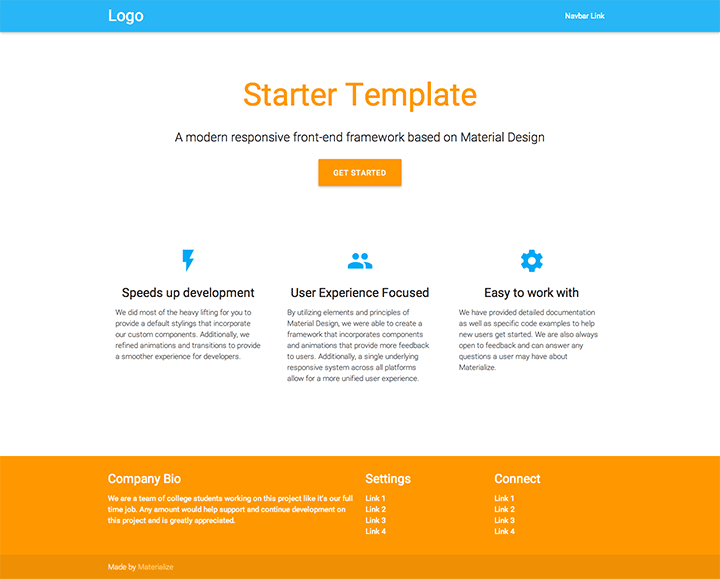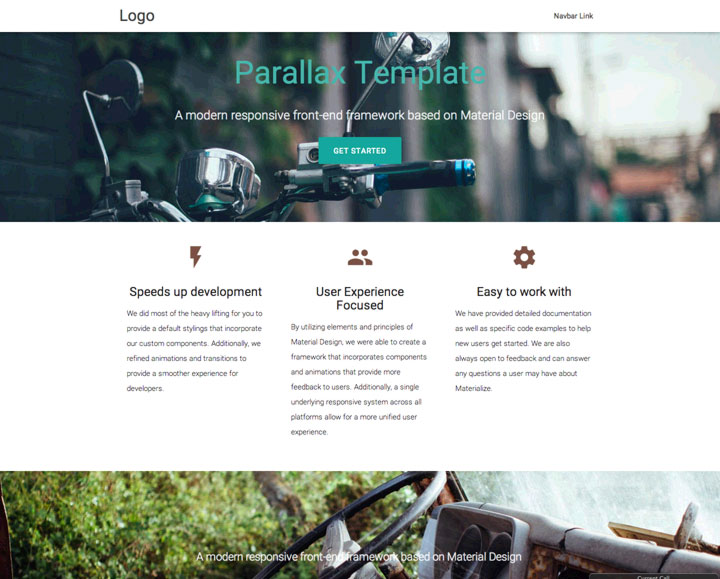Getting started
Learn how to easily start using Materialize and integrate it into your project.
Download
Materialize comes in two different forms. You can select which version you want depending on your preference and expertise. To start using Materialize, all you have to do is download one of the options below.
Materialize
This is the standard version that comes with both the minified and unminified CSS and JavaScript files. This option requires little to no setup. Use this if you are unfamiliar with Sass.
Downloadfile_downloadSass
This version contains the source SCSS files. By choosing this version you have more control over which components to include. You will need a Sass compiler if you choose this option.
Download with Sourcefile_downloadSupport our work
Thank you for downloading. We hope you find Materialize useful in your next project. We would appreciate if you help us spread the word about Materialize by giving us a star or support our work.
CDN
You can find all the versions of the CDN at jsDelivr.
Copied!
content_copy
<!-- Compiled and minified CSS -->
<link rel="stylesheet" href="https://cdn.jsdelivr.net/npm/@materializecss/materialize@2.2.2/dist/css/materialize.min.css">
<!-- Compiled and minified JavaScript -->
<script src="https://cdn.jsdelivr.net/npm/@materializecss/materialize@2.2.2/dist/js/materialize.min.js"></script>
NPM
You can also get the latest release using NPM. This release contains source files as well as the compiled CSS and JavaScript files.
npm install @materializecss/materializeYarn
Or you can get the latest release using yarn as your favorite package manager.
yarn add @materializecss/materializeSetup
Project Structure
After downloading, extract the files into the directory where your website is located. Your directory will look something like this.
You'll notice that there are two sets of the files. The
min means that the file is "compressed" to reduce load times. These minified files are usually used in production while it is
better to use the unminified files during development.
MyWebsite/
|--css/
| |--materialize.css
|
|--fonts/
| |--roboto/
|
|--js/
| |--materialize.js
|
|--index.html
HTML Setup
Next you just have to make sure you link the files properly in your webpage. Generally it is wise to import javascript files at the end of the body to reduce page load time. Follow the example below on how to import Materialize into your webpage.
Copied!
content_copy
<!DOCTYPE html>
<html>
<head>
<!--Import Google Icon Font-->
<link href="https://fonts.googleapis.com/icon?family=Material+Icons" rel="stylesheet">
<!--Import materialize.css-->
<link type="text/css" rel="stylesheet" href="css/materialize.min.css" media="screen,projection"/>
<!--Let browser know website is optimized for mobile-->
<meta name="viewport" content="width=device-width, initial-scale=1.0"/>
</head>
<body>
<!--JavaScript at end of body for optimized loading-->
<script type="text/javascript" src="js/materialize.min.js"></script>
</body>
</html>
Templates
We have created some starter templates so you can easily start designing your website with minimal setup up time. Browse through our collection and download your best fit.
Starter Template

This is the simplest starter page with a Header, Call-to-Action, and Icon Features.
Demo search Downloadfile_downloadParallax Template

This is the simplest starter page with a Header, Call-to-Action, and Icon Features.
Demosearch Downloadfile_downloadSass Setup
This section is only relevant if you chose to download the Sass version of Materialize.
Compiling Sass
Instead of having a css folder, you will find that the download instead contains many .scss files which contain the styles of individual components. Unfortunately, the browser cannot interpret Sass, so you must have your Sass compiler compile the scss/materialize.scss into a regular CSS file. At this point you can link this newly outputted file in your HTML page.
MyWebsite/
|--css/
| |--materialize.css <-- compiled from scss/materialize.scss
|
|--js/
| |--materialize.js
|
|--scss/
| |--materialize.scss
| |--components/
|
|--index.html
